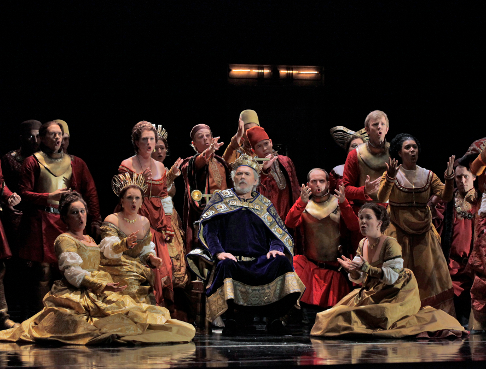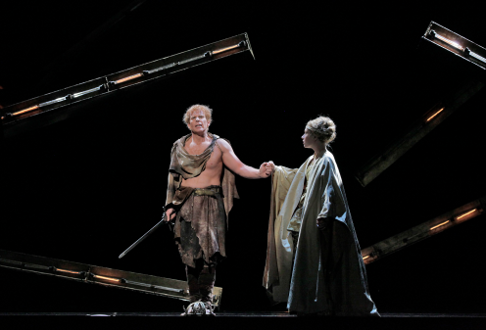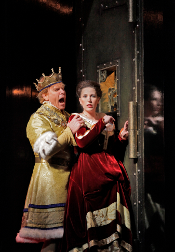![Roger Honeywell (Segismundo) & John Cheek (King Basilio) [Photo by Ken Howard courtesy of Santa Fe Opera]](http://www.operatoday.com/_MG_8479.png)
26 Jul 2010
Santa Fe’s Mixed Dreams
Fairy Tales are often short on character, motivation and development. The stock figures are either good or bad, they are usually archetypal, and stand not only for themselves but larger dimensions of humanity.
English Touring Opera are delighted to announce a season of lyric monodramas to tour nationally from October to December. The season features music for solo singer and piano by Argento, Britten, Tippett and Shostakovich with a bold and inventive approach to making opera during social distancing.
This tenth of ten Live from London concerts was in fact a recorded live performance from California. It was no less enjoyable for that, and it was also uplifting to learn that this wasn’t in fact the ‘last’ LfL event that we will be able to enjoy, courtesy of VOCES8 and their fellow vocal ensembles (more below …).
Ever since Wigmore Hall announced their superb series of autumn concerts, all streamed live and available free of charge, I’d been looking forward to this song recital by Ian Bostridge and Imogen Cooper.
The Sixteen continues its exploration of Henry Purcell’s Welcome Songs for Charles II. As with Robert King’s pioneering Purcell series begun over thirty years ago for Hyperion, Harry Christophers is recording two Welcome Songs per disc.
Although Stile Antico’s programme article for their Live from London recital introduced their selection from the many treasures of the English Renaissance in the context of the theological debates and upheavals of the Tudor and Elizabethan years, their performance was more evocative of private chamber music than of public liturgy.
In February this year, Albanian soprano Ermonela Jaho made a highly lauded debut recital at Wigmore Hall - a concert which both celebrated Opera Rara’s 50th anniversary and honoured the career of the Italian soprano Rosina Storchio (1872-1945), the star of verismo who created the title roles in Leoncavallo’s La bohème and Zazà, Mascagni’s Lodoletta and Puccini’s Madama Butterfly.
Evidently, face masks don’t stifle appreciative “Bravo!”s. And, reducing audience numbers doesn’t lower the volume of such acclamations. For, the audience at Wigmore Hall gave soprano Elizabeth Llewellyn and pianist Simon Lepper a greatly deserved warm reception and hearty response following this lunchtime recital of late-Romantic song.
Collapsology. Or, perhaps we should use the French word ‘Collapsologie’ because this is a transdisciplinary idea pretty much advocated by a series of French theorists - and apparently, mostly French theorists. It in essence focuses on the imminent collapse of modern society and all its layers - a series of escalating crises on a global scale: environmental, economic, geopolitical, governmental; the list is extensive.
For this week’s Live from London vocal recital we moved from the home of VOCES8, St Anne and St Agnes in the City of London, to Kings Place, where The Sixteen - who have been associate artists at the venue for some time - presented a programme of music and words bound together by the theme of ‘reflection’.
'Such is your divine Disposation that both you excellently understand, and royally entertaine the Exercise of Musicke.’
Amongst an avalanche of new Mahler recordings appearing at the moment (Das Lied von der Erde seems to be the most favoured, with three) this 1991 Mahler Second from the 2nd Kassel MahlerFest is one of the more interesting releases.
‘And there was war in heaven: Michael and his angels fought against the dragon; and the dragon fought and his angels, And prevailed not; neither was their place found any more in heaven … that old serpent … Satan, which deceiveth the whole world: he was cast out into the earth, and his angels were cast out with him.’
If there is one myth, it seems believed by some people today, that probably needs shattering it is that post-war recordings or performances of Wagner operas were always of exceptional quality. This 1949 Hamburg Tristan und Isolde is one of those recordings - though quite who is to blame for its many problems takes quite some unearthing.
There was never any doubt that the fifth of the twelve Met Stars Live in Concert broadcasts was going to be a palpably intense and vivid event, as well as a musically stunning and theatrically enervating experience.
‘Love’ was the theme for this Live from London performance by Apollo5. Given the complexity and diversity of that human emotion, and Apollo5’s reputation for versatility and diverse repertoire, ranging from Renaissance choral music to jazz, from contemporary classical works to popular song, it was no surprise that their programme spanned 500 years and several musical styles.
The Academy of St Martin in the Fields have titled their autumn series of eight concerts - which are taking place at 5pm and 7.30pm on two Saturdays each month at their home venue in Trafalgar Square, and being filmed for streaming the following Thursday - ‘re:connect’.
The London Symphony Orchestra opened their Autumn 2020 season with a homage to Oliver Knussen, who died at the age of 66 in July 2018. The programme traced a national musical lineage through the twentieth century, from Britten to Knussen, on to Mark-Anthony Turnage, and entwining the LSO and Rattle too.
With the Live from London digital vocal festival entering the second half of the series, the festival’s host, VOCES8, returned to their home at St Annes and St Agnes in the City of London to present a sequence of ‘Choral Dances’ - vocal music inspired by dance, embracing diverse genres from the Renaissance madrigal to swing jazz.
Just a few unison string wriggles from the opening of Mozart’s overture to Le nozze di Figaro are enough to make any opera-lover perch on the edge of their seat, in excited anticipation of the drama in music to come, so there could be no other curtain-raiser for this Gala Concert at the Royal Opera House, the latest instalment from ‘their House’ to ‘our houses’.
"Before the ending of the day, creator of all things, we pray that, with your accustomed mercy, you may watch over us."
![Roger Honeywell (Segismundo) & John Cheek (King Basilio) [Photo by Ken Howard courtesy of Santa Fe Opera]](http://www.operatoday.com/_MG_8479.png)
Fairy Tales are often short on character, motivation and development. The stock figures are either good or bad, they are usually archetypal, and stand not only for themselves but larger dimensions of humanity.
They tend, thus, to be simplistic and easily understood by children. They also tend to be tricky sources for writing effective opera.
When used as the text for an opera, which sometimes can be effectively done, as in Engelbert Humperdinck’s wonderful Hansel and Gretel, it is the musical score that makes the work successful. All the blank spaces are filled in and emotion is established by the music. If this does not happen — trouble.
Trouble is what Santa Fe Opera had plenty of in mounting the never-before-staged 1978 opera, Life is a Dream, by (now retired) Amherst professor of music, composer Lewis Spratlan. The composer was on hand in Santa Fe for the opera’s rehearsal period and generously conducted symposia and gave interviews, and he let it be known that we were all in for a treat with Life is a Dream.
In a way, we were. Visually! The set is a most ingenious array of lighted barrier gates — think of the ‘arms’ that descend over a road at railroad crossings. A score of such members, fitted out with incandescent light tubes, would swing down or up from stage right and left, on visible ‘gears,’ comic strip version, providing all sorts of moods and meanings. We were in a forest so they were tree limbs; our characters were in danger so they could hide behind the barriers and be safe, we needed a ceiling, so all the light-arms ascended to the top of the stage and formed a pleasing ‘ceiling’ and source of light for the action below. If we needed a mood change, the tubes of warm light could grow cooler, or less or more intense. It was tremendously impressive and innovative, and my hat is off to scenic designer David Korins and lighting designer Japhy Weidman, as well as over-all stage director Kevin Newbury, who enjoyed nothing less than a triumph with their concept of mis-en-scène.
The evening also benefitted from Jessica Jahn’s elegant formal costumes of, I suppose, the era of the opera’s dramatic source, Pedro Calderón de la Barca’s 16th Century play, La Vida es Sueño (libretto adaptation by James Maraniss). A major stage element was a curiously Dada-esque (think Marcel Duchamps) ‘tower’ that rose from the stage floor, all round and mechanical and metallic with strong doors that contained the wild and dangerous son of King Basilio who had to be exiled to a forest, kept from society, and from endangering the King. The tall tower, on occasion, would move lower into the stage floor and become a throne, with amusing rather faux-Land of Oz lighting, and sometimes it would disappear entirely to make room for the King’s court. It was all great visual fun. Bravo!
 John Cheek as King Basilio and Chorus
John Cheek as King Basilio and Chorus
Meanwhile, back at the forest, the wild and crazy boy, Segismundo, is now a grown up Prince, though he does not know it. But the King, old and near death, is having second thoughts, and risks bringing the boy in from the cold to test him out as a functioning Heir (though the ambitious Duke Astolfo aspires to the throne). Alas, young Seggie does not pass the test, for he throws an unsatisfactory servant off a balcony in to the sea, and engages in further unpleasantness. Back he goes to the tower in the forest — where a few more things happen, and whether dreaming or not dreaming, the Prince vows to behave himself and be a good monarch, while all rejoice. Yep, a happy ending. Interestingly enough, vocal music is abandoned for the final climactic lines of the play/opera and the words are clearly spoken by our reformed hero, a quite clever device for they could be heard and understood.
Now we come full circle: Spratlan’s opera did not convince me for several reasons, quite aside from the simplistic tale whence it springs. First among the problems is a cerebral, if sometimes witty, score that bears no lyric material whatsoever. Virtually all vocal writing is spiky, cruelly high and low and vehement and loud, and for Prince Segismundo, especially, it requires huge reserves of power and range that no tenor since Lauritz Melchior could possess. None of the singers, even in the few potentially romantic moments between the tenor Prince and his soprano would-be girlfriends, held any emotional warmth.
 Roger Honeywell as Segismundo and Carin Gilfry as Estrella
Roger Honeywell as Segismundo and Carin Gilfry as Estrella
Most people, this one included, go to the opera to be entertained and moved, touched by emotion, which may be resolved or left unresolved, but there needs to be a lyric line and reach of voice that conjures up human feelings, in a compound of words and music, that make for lyric drama. Even the astringency of a masterwork such as Alban Berg’s Wozzeck, for all its sharp-edged atonality offers a strong core of emotion (and tonality). Mr. Spratlin’s sometimes-tonal score is marvelous in its use of wood winds, its musical tropes and schemes that sometimes even comment upon and illustrate words or situations on the stage; but it offers precious little ‘singing’ music, with a dry result that fails in the end to capture our sympathy. Now and again one can be reminded of the music for Façade of William Walton, or patches of Britten or Barber operas. If only Dream gave us a few touches of emotion as does Barber’s Knoxville, Summer 1915, we would have something to take home. But Mr. Spratlan has chosen to remain in the classroom instead.
 Roger Honeywell as Segismundo and Ellie Dehn as Rosaura
Roger Honeywell as Segismundo and Ellie Dehn as Rosaura
Let’s end on a positive note: In addition to providing a memorable
production for the world premiere run of Life is a Dream, Santa Fe
Opera assembled a remarkable and I might say brave cast that achieved miracles.
The complex music must be very difficult to learn (if the King had his eye on
conductor Leonard Slatkin at all times, who can blame him?), and it is surely
hard to sing. The cast, all of them, turned in remarkably accomplished
performances.
Tenor Roger Honeywell exceeded himself in the high-and-loud role of the toubled Prince, and I hope his voice benefits from a lot of rest between shows, for he is sorely taxed by the exploitative, even anti-vocal writing. James Maddalena and Craig Verm, baritones, were effective as the Prince’s mentor and rival, respectively, Verm displaying an unusually attractive vocal gift. Keith Jameson as the court’s jester Clarin had to sing, juggle, play tricks and be ever-present all evening, and he excelled, as did the beautiful soprano of Ellie Dehn. Her music, of all, allowed a few moments of dulcet tone, which she had in abundance. Bass John Cheek sounded old, noble and wobbly, which was appropriate as the weakening King, while Carin Gilfrey, Darik Knutsen, Thomas Forde and Heath Hubert were up to the demands of their supporting roles.
Musical director Leonard Slatkin, a sometimes controversial figure in operatic conducting, proved exactly right for the Spratlan score, handling it with seeming ease and expert efficiency.
James A. Van Sant © 2010